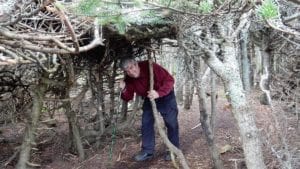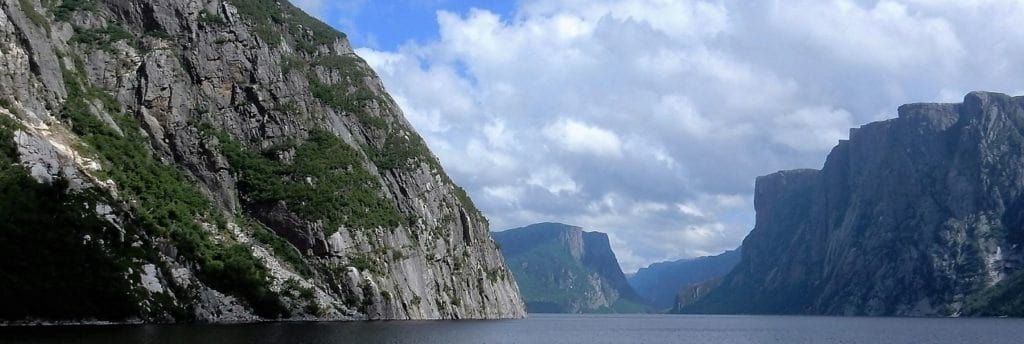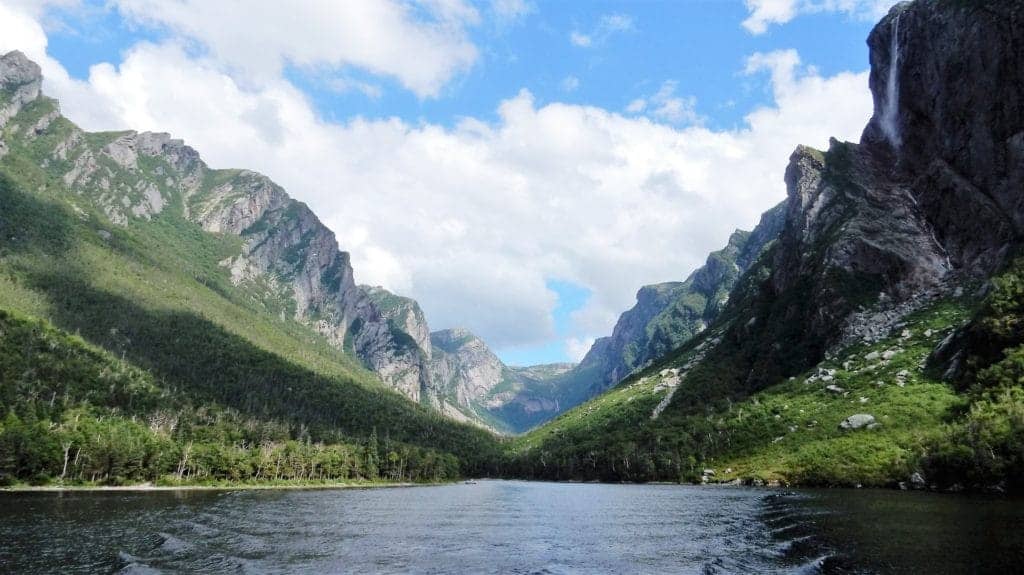Gross Morne North
Mike and I are staying in the northern section of Gros Morne National Park for a few days. We will then move down to the southern section for a few more days. We will probably spend one to two weeks in the park. The walks and views around here are great. Gros Morne National Park is a UNESCO world heritage site. Within the park and across the west coast of Newfoundland are the Long Range Mountains which are the most northern section of the Appalachian Mountain range. The park is apparently a world class site for geologists. Even without knowing much about geology you can appreciate the sheer beauty of the park.
Mike and I haven’t really taken advantage of the Canada Parks’ rangers and geologists that are available to visitors yet. They hold talks, guide walks and answer questions. We have done a lot of walking but not in groups of people. We were at Arches Provincial Park last week and both Mike and I commented on how crowded it was. I counted. Besides us there were 12 other people there spread across the parking lot, the beach and the grass. We have really got used to having all this beauty and peace to ourselves. I can’t say peace and quiet because with this constant wind I don’t think it is ever completely quiet.
Let me tell you a little bit about Gros Morne itself and what makes it so fascinating to people from around the world. The theory is that hundreds of millions of years ago the continents shifted, broke apart and came together again and collided in the area of Gros Morne. They say that here North America, Europe and Africa all split apart. If you think of how two cars crumple up when they collide, that is basically what happened a long time ago. When the continents collided the layers of land crumbled, some of it tilted up and there are sections where the layers of earth’s history are actually seen vertically rather than horizontally. Gros Morne was the site were the proof of the theory of continental drift was first discovered.
When we were out on a tour boat ride the guide was telling us that they had found fossils of whale bones half way up cliffs that are 50% higher than the CN Tower. Along with other fossils this demonstrated that at different times in geological history Gros Morne was underneath oceans that came and went. The rocky cliffs of today were once shallow sandy beaches. If you were here enjoying the tropical weather you would have been standing at the edge of the Iapetus Ocean which was the precursor to the Atlantic Ocean. Bet you didn’t know that before you read this 🙂 . The park is internationally recognized as a place where you can see the ending of one geological period and the beginning of the next geological period all in vertical layers of rock. This is apparently extremely rare. For the budding geologists these would be the beginning of the Ordovician period and the end of the Cambrian period.
20 years ago when we were here we took a boat trip on Western Brook Pond. We still remember the towering cliffs and were determined to take the trip again. It is a 3km walk to get to the boat dock. Western Brook Pond was created by multiple glaciers over time carving out the landscape and exposing the ancient rocks and huge cliffs. Western Brook Pond is called a fresh water fjord. It was part of the ocean at one point during the ice age. When the glaciers finally melted the last time their weight was lifted off the earth. The surface of the earth rose and cut off the fjord from the lake and it was eventually filled with fresh water. This water has really few nutrients which means almost no animals or plants can live in it. It is said to be some of the cleanest water in the world. It takes about 15 years to refresh the water in this lake. A normal lake this size would refresh its water multiple times in one year. One of the many waterfalls that you see from the boat trip is called the Pissing Mare Falls. It is one of the highest 200 waterfalls in the world.
 For Mike and I Gros Morne is great. Canada Parks has set up all sorts of walks ranging from 1/2 km to 16 km and they have rated them from easy to difficult. You can also do a four day trek across the tops of the tablelands but you need special permission and expertise for that. Earlier today Mike and I went on a 6 kilometre hike along the coast that was rated as easy. There is a 10 kilometre intermediate hike that goes up to some waterfalls that I am debating about doing. We are two sedentary, retired seniors so I have to think about this. We have done 10 km in one day before without any problems but that was on multiple walks with breaks and meals in between. I am not sure about this one walk and yes I know that for many of you this might not be much but it is a stretch for those of us new to this idea of intermediate level hiking.
For Mike and I Gros Morne is great. Canada Parks has set up all sorts of walks ranging from 1/2 km to 16 km and they have rated them from easy to difficult. You can also do a four day trek across the tops of the tablelands but you need special permission and expertise for that. Earlier today Mike and I went on a 6 kilometre hike along the coast that was rated as easy. There is a 10 kilometre intermediate hike that goes up to some waterfalls that I am debating about doing. We are two sedentary, retired seniors so I have to think about this. We have done 10 km in one day before without any problems but that was on multiple walks with breaks and meals in between. I am not sure about this one walk and yes I know that for many of you this might not be much but it is a stretch for those of us new to this idea of intermediate level hiking.
There are two places for launching a boat in the park. I would really love to take our boat out among some of these cliffs. Mike says that would be great if the wind dies down at least a little but that hasn’t happened so far. It is also quite cool and the combination of cool temperatures and high winds in a boat very low to the water isn’t hugely appealing. We will probably move from this section of the park tonight or tomorrow and go a little further south. They have a lot of walks in that area that would be nice to do as well. There is an area called Tablelands that we are told look like a barren desert. The Tablelands are a piece of the earth’s mantle. They are made up of a rock that is normally found 15 to 30 km below the surface of the earth. This is supposed to be one of the finest examples of the earth’s mantle that geologists can see anywhere in the world.
I promise that our next article will less geology oriented but while you are at Gros Morne you are just inundated with the uniqueness of this area and that is very geology related.



Leave a Reply